Winniestar446
On this page, you find all documents, package deals, and flashcards offered by seller WINNIESTAR446.
- 76
- 0
- 0
Community
- Followers
- Following
76 items
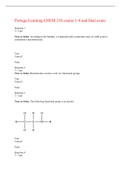
Portage Learning CHEM 210 exams 1-8 and final exam
Portage Learning CHEM 210 exams 1-8 and final exam Question 1 3 / 3 pts True or False: According to the Module, a compound with a molecular mass of 1,000 g/mol is considered a macromolecule. True Correct! False Question 2 3 / 3 pts True or False: Biomolecules can have only two functional groups. True Correct! False Question 3 3 / 3 pts True or False: The following functional group is an alcohol. True Correct! False Question 4 3 / 3 pts True or False: In ...
- Exam (elaborations)
- • 124 pages •
Portage Learning CHEM 210 exams 1-8 and final exam Question 1 3 / 3 pts True or False: According to the Module, a compound with a molecular mass of 1,000 g/mol is considered a macromolecule. True Correct! False Question 2 3 / 3 pts True or False: Biomolecules can have only two functional groups. True Correct! False Question 3 3 / 3 pts True or False: The following functional group is an alcohol. True Correct! False Question 4 3 / 3 pts True or False: In ...
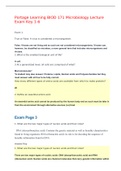
Portage Learning BIOD 171 Microbiology Lecture Exam Key 1-6
Portage Learning BIOD 171 Microbiology Lecture Exam Key 1-6 Exam 1. True or False: A virus is considered a microorganism. False. Viruses are not living and as such are not considered microorganisms. Viruses can, however, be classified as microbes, a more general term that includes microorganisms and viruses. 2. What is the smallest biological unit of life? A cell. 3. At a generalized level, all cells are comprised of what? Macromolecules* *A student may also answer: Proteins,...
- Exam (elaborations)
- • 34 pages •
Portage Learning BIOD 171 Microbiology Lecture Exam Key 1-6 Exam 1. True or False: A virus is considered a microorganism. False. Viruses are not living and as such are not considered microorganisms. Viruses can, however, be classified as microbes, a more general term that includes microorganisms and viruses. 2. What is the smallest biological unit of life? A cell. 3. At a generalized level, all cells are comprised of what? Macromolecules* *A student may also answer: Proteins,...
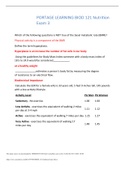
PORTAGE LEARNING BIOD 121 Nutrition Exam 3
PORTAGE LEARNING BIOD 121 Nutrition Exam 3 Which of the following questions is NOT true of the basal metabolic rate (BMR)? Physical activity is a component of the BMR Define the term hyperplasia. Hyperplasia is an increase the number of fat cells in our body Using the guidelines for Body Mass Index someone with a body mass index of 18.5 to 24.9 would be considered . at a healthy weight estimates a person’s body fat by measuring the degree of resistance to an electrical flow. Bioele...
- Exam (elaborations)
- • 5 pages •
PORTAGE LEARNING BIOD 121 Nutrition Exam 3 Which of the following questions is NOT true of the basal metabolic rate (BMR)? Physical activity is a component of the BMR Define the term hyperplasia. Hyperplasia is an increase the number of fat cells in our body Using the guidelines for Body Mass Index someone with a body mass index of 18.5 to 24.9 would be considered . at a healthy weight estimates a person’s body fat by measuring the degree of resistance to an electrical flow. Bioele...
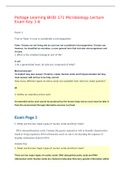
Portage Learning BIOD 171 Microbiology Lecture Exam Key 1-6
Portage Learning BIOD 171 Microbiology Lecture Exam Key 1-6 Exam 1. True or False: A virus is considered a microorganism. False. Viruses are not living and as such are not considered microorganisms. Viruses can, however, be classified as microbes, a more general term that includes microorganisms and viruses. 2. What is the smallest biological unit of life? A cell. 3. At a generalized level, all cells are comprised of what? Macromolecules* *A student may also answer: Proteins,...
- Exam (elaborations)
- • 34 pages •
Portage Learning BIOD 171 Microbiology Lecture Exam Key 1-6 Exam 1. True or False: A virus is considered a microorganism. False. Viruses are not living and as such are not considered microorganisms. Viruses can, however, be classified as microbes, a more general term that includes microorganisms and viruses. 2. What is the smallest biological unit of life? A cell. 3. At a generalized level, all cells are comprised of what? Macromolecules* *A student may also answer: Proteins,...
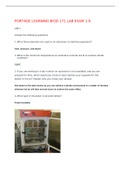
PORTAGE LEARNING BIOD 171 LAB EXAM 1-9
PORTAGE LEARNING BIOD 171 LAB EXAM 1-9 LAB 1 Answer the following questions 1. What three elements are used in an autoclave to sterilize equipment? heat, pressure, and steam 2. What is the minimum temperature an autoclave must be set at to achieve sterile condition? 125°C 3. If you are working in a lab in which an autoclave is not available, and you are pressed for time, which would you chose to best sterilize your equipment? Hot steam or hot air? Explain why you chose your...
- Exam (elaborations)
- • 23 pages •
PORTAGE LEARNING BIOD 171 LAB EXAM 1-9 LAB 1 Answer the following questions 1. What three elements are used in an autoclave to sterilize equipment? heat, pressure, and steam 2. What is the minimum temperature an autoclave must be set at to achieve sterile condition? 125°C 3. If you are working in a lab in which an autoclave is not available, and you are pressed for time, which would you chose to best sterilize your equipment? Hot steam or hot air? Explain why you chose your...
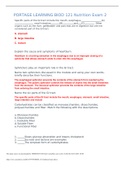
PORTAGE LEARNING BIOD 121 Nutrition Exam 2
PORTAGE LEARNING BIOD 121 Nutrition Exam 2 Specific parts of the GI tract include the mouth, esophagus, (A) , small intestine, (B) and (C) . Other organs such as the liver, gallbladder and pancreas aid in digestion but are not considered part of the GI tract. A. stomach B. large intestine C. rectum Explain the cause and symptoms of heartburn. Heartburn is a burning sensation in the esophagus due to an improper closing of a sphincter that allows stomach acids to enter into the esophagu...
- Exam (elaborations)
- • 3 pages •
PORTAGE LEARNING BIOD 121 Nutrition Exam 2 Specific parts of the GI tract include the mouth, esophagus, (A) , small intestine, (B) and (C) . Other organs such as the liver, gallbladder and pancreas aid in digestion but are not considered part of the GI tract. A. stomach B. large intestine C. rectum Explain the cause and symptoms of heartburn. Heartburn is a burning sensation in the esophagus due to an improper closing of a sphincter that allows stomach acids to enter into the esophagu...
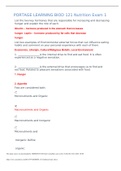
PORTAGE LEARNING BIOD 121 Nutrition Exam 1
PORTAGE LEARNING BIOD 121 Nutrition Exam 1 List the two key hormones that are responsible for increasing and decreasing hunger and explain the role of each. Gherlin – hormone produced in the stomach that increases hunger. Leptin – hormone produced by fat cells that decrease hunger. List two examples of Environmental external forces that can influence eating habits and comment on your personal experience with each of them. Economics, Lifestyle, Cultural/Religious Beliefs, Local Environmen...
- Exam (elaborations)
- • 5 pages •
PORTAGE LEARNING BIOD 121 Nutrition Exam 1 List the two key hormones that are responsible for increasing and decreasing hunger and explain the role of each. Gherlin – hormone produced in the stomach that increases hunger. Leptin – hormone produced by fat cells that decrease hunger. List two examples of Environmental external forces that can influence eating habits and comment on your personal experience with each of them. Economics, Lifestyle, Cultural/Religious Beliefs, Local Environmen...
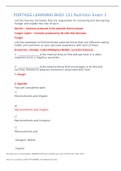
PORTAGE LEARNING BIOD 121 Nutrition Exam 1
PORTAGE LEARNING BIOD 121 Nutrition Exam 1 List the two key hormones that are responsible for increasing and decreasing hunger and explain the role of each. Gherlin – hormone produced in the stomach that increases hunger. Leptin – hormone produced by fat cells that decrease hunger. List two examples of Environmental external forces that can influence eating habits and comment on your personal experience with each of them. Economics, Lifestyle, Cultural/Religious Beliefs, Local Environmen...
- Exam (elaborations)
- • 5 pages •
PORTAGE LEARNING BIOD 121 Nutrition Exam 1 List the two key hormones that are responsible for increasing and decreasing hunger and explain the role of each. Gherlin – hormone produced in the stomach that increases hunger. Leptin – hormone produced by fat cells that decrease hunger. List two examples of Environmental external forces that can influence eating habits and comment on your personal experience with each of them. Economics, Lifestyle, Cultural/Religious Beliefs, Local Environmen...
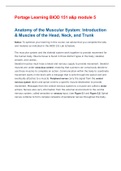
Portage Learning BIOD 151 a&p module 5
Portage Learning BIOD 151 a&p module 5 Anatomy of the Muscular System: Introduction & Muscles of the Head, Neck, and Trunk Notice: To optimize your learning in this course, we advise that you complete the labs and modules as indicated in the BIOD 151 Lab Schedule. The muscular system and the skeletal system work together to provide movement for the human body. Muscle tissue is found in three distinct types in the body; skeletal, smooth, and cardiac. Skeletal muscles must have a blood and...
- Exam (elaborations)
- • 149 pages •
Portage Learning BIOD 151 a&p module 5 Anatomy of the Muscular System: Introduction & Muscles of the Head, Neck, and Trunk Notice: To optimize your learning in this course, we advise that you complete the labs and modules as indicated in the BIOD 151 Lab Schedule. The muscular system and the skeletal system work together to provide movement for the human body. Muscle tissue is found in three distinct types in the body; skeletal, smooth, and cardiac. Skeletal muscles must have a blood and...
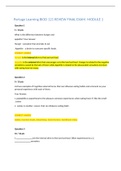
Portage Learning BIOD 121 REVIEW FINAL EXAM. MODULE 1
Portage Learning BIOD 121 REVIEW FINAL EXAM. MODULE 1 Question 1 5 / 10 pts What is the difference between hunger and appetite? Your Answer: Hunger : sensation that prompts to eat Appetite : a desire to sonsume specific foods. CORRECT ANSERS Hunger is the internal drive to find and eat food. Appetite is the external drive that encourages us to find and eat food . Hunger is related to the negative sensations caused by the lack of food, while Appetite is related to the pleasurable sen...
- Exam (elaborations)
- • 44 pages •
Portage Learning BIOD 121 REVIEW FINAL EXAM. MODULE 1 Question 1 5 / 10 pts What is the difference between hunger and appetite? Your Answer: Hunger : sensation that prompts to eat Appetite : a desire to sonsume specific foods. CORRECT ANSERS Hunger is the internal drive to find and eat food. Appetite is the external drive that encourages us to find and eat food . Hunger is related to the negative sensations caused by the lack of food, while Appetite is related to the pleasurable sen...
